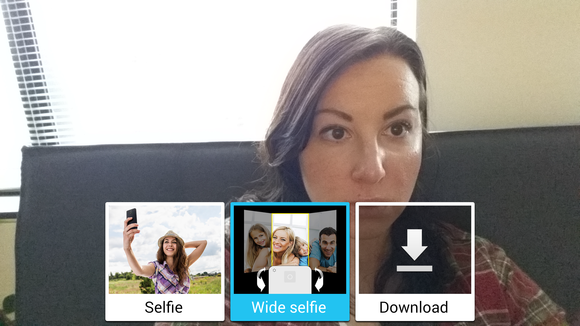The Galaxy Note 4 is quite possibly one of the best smartphones Samsung has ever concocted.
It’s outfitted in a seriously stylish metal outfitting faux-leather backing, features a Quad HD display for a high-resolution viewing experience, comes bundled with the ever-so-useful S-n stylus. It’s also a bonafide replacement to carrying around a small-sized phone mid-sized tablet with you when all you want is a better screen for reading watching movies.
But the best thing about the Galaxy Note 4 is that it feels like Samsung took every little comment stuffed into its cobweb-covered suggestion box actually listened to what its users want.
A br spankin’ new body
 Rob Schultz
Rob SchultzThe Note 4.
If you’ve read my previous reviews, you know that I haven’t always been too fond of large phones because they’ve been difficult to wield. But something snapped in me when I picked up the 6.04 inch by 3.09 inch by 0.33 inch Galaxy Note 4. I’m not sure if it’s because I’ve been carrying both a tablet a smartphone with me on my commute for months now, or because I’ve finally realized how much work I can get done on a bigger screen. Or, maybe it’s simply the fact that I can type faster with two thumbs on a wider display versus a smaller, narrower one. Either way, I found that the Note 4’s size, in addition to its multitasking features, made me forget all about my tablet.

The Galaxy Note 4, in all of its hheld glory.
ereas the Note 3 was merely a minor improvement over its predecessor, this year’s Note 4 feels like an entirely new product. The phone’s faux-leather backing actually feels leathery, while the metal trim—that beautiful metal trim that I fell in love with when I first laid eyes on the Galaxy pha—gives the Note 4 that modern GQ-like business aesthetic that Samsung has attempted to achieve with the Note series since generation one. The metal chassis does add a little bit more heft to the device, but at least now it feels like a sturdy, premium piece of hardware. I sincerely hope this design refresh sets the precedent for all of Samsung’s forthcoming devices.
 Rob Schultz
Rob SchultzThe Note 4’s faux-leather backside doesn’t look so …faux.
The Note 4 continues on with Samsung’s storied tradition of placing a physical Home button between Android’s two other navigational buttons. It also doubles as a fingerprint scanner.

The Note 4’s navigatonal controls.
Android purists may find issue with the fact that the Note 4 switches the multitasking back-buttons— that they’re stuck that way, since the buttons are embedded in the chassis. I’d rather that Samsung switch over to using stock Android’s on-screen navigation controls, even if they do take up a bit of screen space. so, double-pressing the Home button still brings up S-Voice, which seems redundant when you have ’s superior Now already available at your fingertips.
Is that a TV in your pocket?
The Galaxy Note 4 employs a 5.7-inch Quad HD display—that’s a 2560×1440 screen, giving it a density of 518 pixels per inc. This puts it in second place for exorbitant amount of pixels in a smartphone, right after ’s G3. The two displays are decidedly different, however, due in part to the fact that they both utilize different display technologies—Samsung uses Super AMOD uses I D—but also because Samsung’s Note 4 is just a tad bigger.

The G3’s Quad HD I D display on the left compared to Samsung’s Galaxy Note 4 Quad HD Super AMOD display on the right. The left features somewhat warm colors, while Samsung’s are more saturated.
ile movies, games, other extremely colorful applications appear bright vivid on the Note 4’s Super AMOD display, there’s still that noticeable color over-saturation that appears in certain applications. en you’re browsing stark white websites, for instance, there’s a bit of a blue-hued tint. It’s obvious when you place the device alongside another type of display technology, but it’s not so apparent that it’ll ruin your entertainment experience. And with Super AMOD, at least you’ll get the blackest blacks.
Battery life is of the essence
Samsung offers two versions of the Galaxy Note 4: one with an octa-core Exynos 5433 processor, one with a quad-core 2.7GHz Qualcomm Snapdragon 805. Both are paired with 3GB of RAM, but the latter is the version that is sold here in the United States, the one that we used throughout testing.
 Rob Schultz
Rob SchultzBackside, complete with heart-rate monitor a tiny speaker hole.
The Note 4 is quite speedy—multitasking is that much better when you have so much power throttling behind you. It also helps that interface doesn’t feel as weighed down as it has in previous generations. As a day-to-day driver, the phone will do just fine running in out of applications, dealing with hoards of notifications, getting you to work with the help of memory intensive apps, like Maps. I’m more curious to see how the Galaxy Note 4 will perform with Samsung’s Gear VR, since it’s meant to be used with the virtual reality headset accessory. Even if you don’t plan on using that device, you can rest assured that the Note 4 features some of the most powerful components on the market.
I watched the phone for a few days to gauge how much life the Note 4 squeezes out of its 3200mAh battery pack. It lasted two a half days—from Saturday morning to Monday afternoon—before it hit 14 percent started screaming for a charge. Annoyingly, the Note 4’s camera app won’t snap a photo with the flash on if it’s below 16 percent battery, so keep that in mind. I know when I’m at a music festival or a night out, I try to squeeze every last dying bit out of my phone before it’s totally out of juice.
Our review unit was an AT&T variant, it struggled to maintain 4G speeds throughout New York City, s Vegas, San Francisco—my HTC One (M8) on Verizon reless fared better in the same locations. Of course, your mileage may vary where you live.
I’m still annoyed that Samsung chose to beef up every other part of the phone, but won’t opt for front-facing stereo speakers. I hope you have a nice pair of earbuds or a Bluetooth speaker to pair with this thing, because anything you listen with the phone’s pitiful rear speaker sounds tinny.
it—let me take a selfie

Various Android-covering journalists at a bar in Manhattan, taken with the Note 4’s de selfie mode.
This year has definitely been the year of the “selfies.” No matter where you turn, there’s another device manufacturer claiming to have the very best front-facing camera.

Need a bigger selfie? Choose de selfie mode.
Samsung’s on the same bwagon: its front-facing 3.7-megapixel camera sensor exists to help you take the great selfies. It also has a neat feature called the de selfie, which essentially lets you take panoramic photo of you your crew or the scenery surrounding you. For higher resolution shots, you can also take selfies with the rear-facing camera; aim it at your face, the Note 4 will beep when you’re in focus. It’s the perfect set of features for the narcissist in you.

The Note 4 (left) versus the Note 3 (right) low-light comparison.

The Note 4 (left) versus Note 3 low-light with flash comparison.
The Galaxy Note 4’s 16-megapixel rear-facing camera is a vast improvement over its predecessor. In addition to a better camera sensor, better low-light performance, a better flash, it also features Advanced Digital Zoom.

Ahh, the beautiful San Francisco-Oakl Bay Bridge. One of my favorites!

Here it is again, zoomed in with the Note 4’s Advanced Digital Zoom. It’s not too bad, eh?
The Note 4’s Advanced Digital Zoom will never be a replacement for true optical zoom, but it works much better than some of the other smartphones out there.
ite it out
 Rob Schultz
Rob SchultzUse S-Note with the embedded S-n to doodle or take notes.
My biggest gripe with the last three generations of S-ns is that the stylus felt stiff offered no tactile feedback whatsoever, but this year’s Note S-n offers a similar drag to what you might experience while writing a note on a piece of actual paper. It makes it easier to write notes doodle, no matter how sloppy you are with a pen.

The story I wrote in S-Note, to give you an example of how I doodle write with the S-n.
ke last year’s version, the S-n features a small button you can click to bring up Air Comm, which has been pared down to four essential features: Action Memo, Smart Select, Image Clip, Screen ite. S-Finder was nixed from the Air Comm menu, while n ndow was converted to Smart Select.

Did someone say “Air Comm”?
l four of Air Comm’s mini-apps have been given a minor feature makeover. Action memo now enables you to pin a note to your Home screen as a sticky note; it functions just like a widget, you can pin multiple notes as you see fit.

From full-blown grocery list to a tiny widget on your Home screen.
Smart select Image clip work similarly: they each clip a selected area, but the former will save to an S-Note scrapbook page while the later will enable you to either save it as an image or share it across various apps.
As for Screen ite, it just blatantly does what it describes: allow you to write on top of a screenshot of your choosing. en you save it, it will be filed away in the Gallery application.
Still Touchwiz…

To the left, a busy little Home screen. To the right, a busy little Application drawer.
The Galaxy Note 4 features the same Touchz Nature UX 3.0 interface that’s stard on all of Samsung’s latest mobile devices, including the Galaxy S5. It comes with a few helpful interface-specific perks that you don’t get on other Android devices, like One-hed operation, which offers options for reducing the screen size or placing controls in easier-to-tap spots so you can more easily use the phone one-hed, increased touch sensitivity, which lets you use the device with gloves on.

p-view tries to emulate the way you’d use a ndows or Mac interface.
My personal favorite is p-up view, a part of MultiView, which open up apps in their own individual windows, allowing you to essentially multitask like you would on a or a Mac. It’s a creative addition on Samsung’s part to attract the business-minded crowd, who might find that moving windows around feels a little more natural than tapping in out of apps to get things done.
If you absolutely have no use for some of the features described, you can opt out of them entirely, though you’re mostly stuck with Samsung’s Touchz Nature UX even if you do spend some time attempting to customizing the interface.

y so blue?
Both Samsung AT&T bundled a bunch of applications with the Note 4 that I never ended up using. Most of Samsung’s apps live behind the Galaxy Apps icon, though apps like Milk Music Flipboard come pre-loaded on the device. so, Samsung did away with My Magazine instead offers the ability to enable Flipboard as the default app that lives all the way to the left of the Home screen—makes sense, considering that the service was just a modified version of Flipboard in first place.
A phab-ulous phablet
 Rob Schultz
Rob SchultzI give this phone an A+!
Yes, the Note 4 is bigger than some of the other flagships out on the market—it’s even bigger than the G3 HTC One (M8), which are both rather large phones. But when you factor in its beautiful screen, powerful hardware, the utility of the S-n, it becomes a worthy consideration.
But as I said in the beginning: it’s not merely the fact that Samsung debuted another phone-tablet hybrid device, it’s that it feels like the company is actually starting to listen to what its users want. The Apps are displayed front center, Samsung’s apps are mostly opt-in, the chassis feels more premium than ever, even Touchwiz is becoming less gaudy with every iteration. Maybe it’s because of ’s iron-fisted dems that we’re starting to see this significant change, or maybe it’s just because Samsung will do anything to stay on top as long as it possibly can. atever the motivation, it’s working. This is Samsung’s best phone ever, one of the best phones of the year.

















